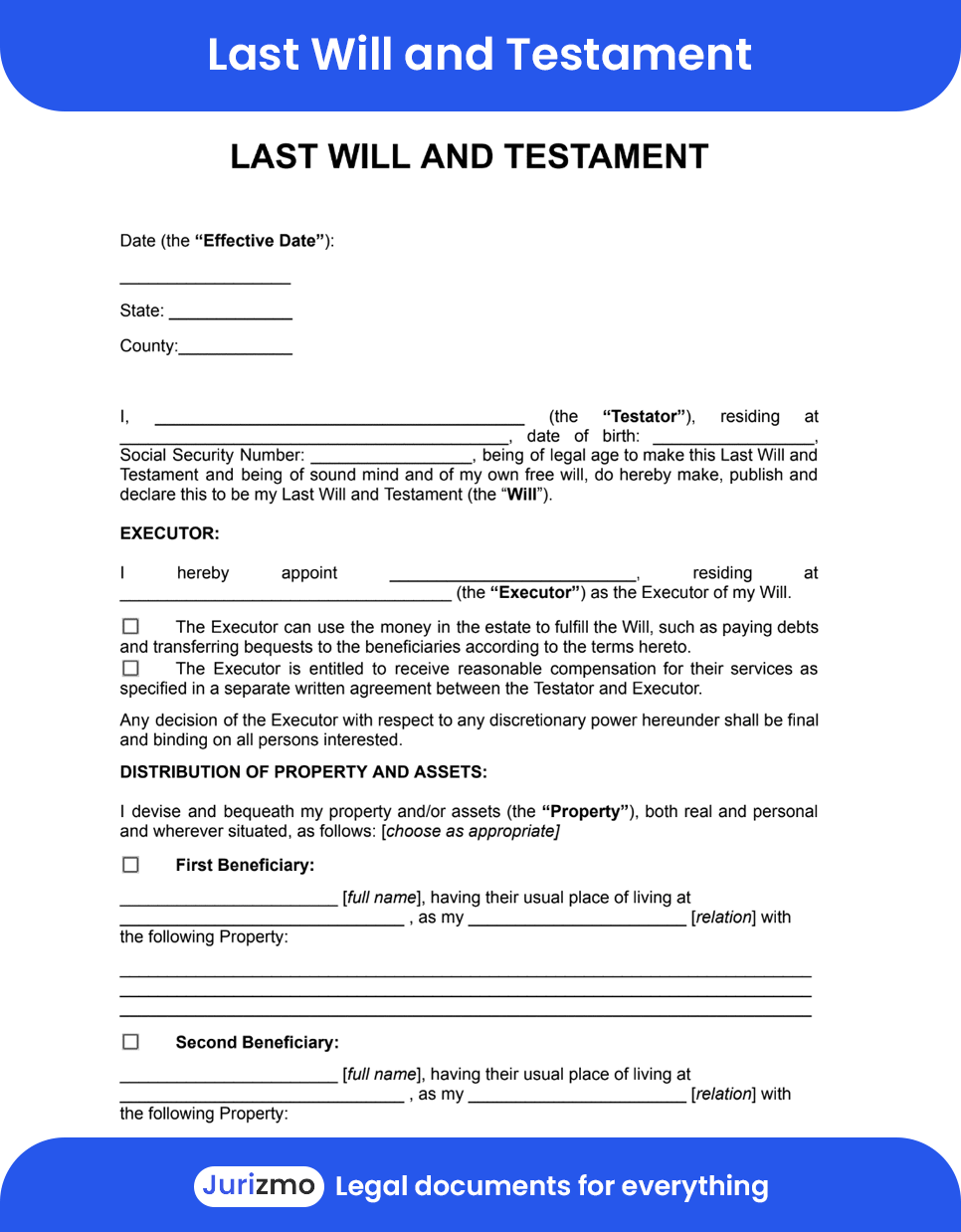When to Use a Last Will and Testament
It is good practice for every adult, regardless of age or current worth of assets, to have a last will and testament to provide clear direction for the distribution of their belongings in the future. Drafting a will is usually related to really important changes or life events.
- Becoming an adult: Creating a last will and testament form becomes legally acceptable and recommended when a person has attained the age of majority, which is roughly 18 years old.
- Significant life events: Marriage or the birth of a child usually means that you have to consider the future and the welfare of these new family members.
- Acquisition of substantial assets: Acquiring important assets like a house or a car or possessing a precious family heirloom makes one think about what will happen with these assets in the future.
- Health concerns or aging: Updating or creating a legal will form may be required if the person gets old or faces any serious health issues.
Bear in mind that all situations are changeable; if this is your case, make sure to revise the document to reflect any adaptations in relationships, assets, or personal inclinations. Setting or altering priorities in the document is easily doable when you use our printable simple last will and testament forms.
Types of Last Will and Testament
While choosing your will, just know that there are different possibilities to consider. Here are three common types of free printable will forms:
- Simple wills: Often employed by those with smaller estates or fewer assets. This kind of will form simply enumerates the beneficiaries – the people or entities that will receive the testator’s possessions – and specifies how those possessions will be split up among them. It may also designate a guardian for minors.
- Testamentary trust wills: This form for will establishes one or more trusts upon the testator’s death, where the deceased’s assets are assigned to the trustee, who is responsible for administering them for the designated beneficiaries. This particular type of testament gives the testator the power to be in charge of the distribution of their wealth even after their death. For instance, establishing terms for the distribution of inheritance to their children or other beneficiaries.
- Joint wills: Typically, two people – spouses or partners – create joint wills. A principal characteristic of this basic will template is a legally enforceable understanding that the survivor will not alter its provisions. Normally, all of the assets of one person pass to the other upon their death, and the remaining assets are divided by the conditions specified in the joint will upon the death of the second person.
Every one of these will forms has a distinct purpose and is made to address the unique requirements of the testator. Determining the appropriate will and testament template is crucial to guaranteeing that your intentions are carried out exactly as you want.
Terms and Parties of a Last Will and Testament
A sample last will and testament involves the following important parties:
- Testator: The individual creating and signing the will. In other words, it’s the individual whose possessions and last desires are being listed.
- Beneficiaries: The individuals, entities, or organizations to whom the testator has decided to allocate his/her assets. The will specifies each beneficiary’s name and the precise assets they are expected to receive.
- Executor: The person appointed by the testator who acts on the testator’s instructions expressed in the will upon the testator’s death. The executor’s duty counts for administering the estate, including allocating assets to beneficiaries as directed and settling debts if the testator had any.
Frequently occurring key terms within the last will and testament forms are:
- Estate: This term refers to all of the testator’s possessions at the time of their death. Properties, cars, valuable things, investments, bank accounts, and even individual debts and obligations are all included.
- Probate: This is the legal procedure wherein a court confirms the decedent’s will following their passing. Following the terms of the will, the procedure also permits the timely settlement of the decedent’s debts and the equitable division of their estate.
How to Create a Last Will and Testament
Filling out a form for a will entails the following steps:
- Identify the testator: Provide personal details of the individual composing and signing the will.
- Appoint an executor: Select a reliable person to be the executor of the decedent’s will.
- Name the beneficiaries: Make sure you list down the names of the individuals or entities that will receive your assets.
- Allocate assets: Describe how your assets will be shared with the beneficiaries. Indicate each beneficiary by name in order to eliminate any confusion that may arise.
- Sign and witness: The testator should sign the will in the presence of witnesses. Ensure that you are aware of the law in your area, as the number of witnesses may differ depending on the jurisdiction.
Our customizable last will and testament form, free of charge, walks you through each step and addresses a variety of situations, making sure that no important details are overlooked. An accurately drafted sample will provide a person with peace of mind, knowing that whatever happens to them, their possessions will be divided according to their final wishes.
Find a simple will template on Jurizmo to ease the writing process. However, it’s important to remember that it does not replace legal advice. We highly recommend having a lawyer review your completed document to make sure everything is in order.
 Preview
Preview

 Preview
Preview
